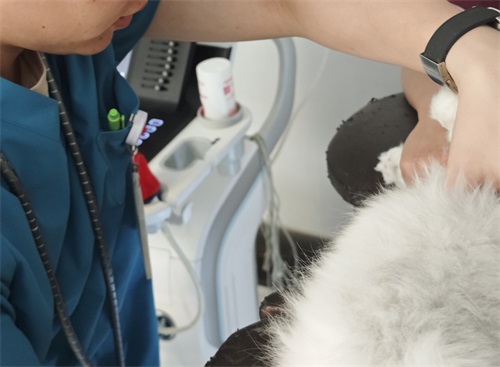In the fast-evolving world of veterinary medicine, fresh graduates are expected to not only understand anatomy and pathology but also master modern diagnostic tools that can drastically improve animal health outcomes. Among these tools, ultrasound stands out for its versatility, non-invasive nature, and diagnostic precision. For new veterinarians, learning how to use ultrasound equipment isn't just an optional skill—it's increasingly becoming a professional advantage that shapes the way they practice from day one.

This article explores how acquiring ultrasound proficiency early in a veterinary career can set new graduates apart, help them deliver better clinical outcomes, and increase their competitiveness in both small and large animal practices. Drawing from global trends and real-world cases, we’ll also look at how ultrasound training bridges the gap between veterinary school and clinical excellence.
Why Ultrasound Skills Matter More Than Ever
Modern veterinary care demands more than traditional auscultation and palpation. Across the United States, Europe, Australia, and parts of Asia, veterinary clinics are equipping themselves with portable, high-resolution ultrasound systems as routine diagnostic tools. According to a 2023 survey by the American College of Veterinary Radiology, over 60% of companion animal practices and nearly 80% of large animal operations now use ultrasound for reproductive, abdominal, musculoskeletal, or cardiac assessments.
For young veterinarians, this signals a major shift. Gone are the days when only senior clinicians handled the ultrasound probe. Today’s job listings increasingly include “proficiency in ultrasonography” as a preferred or required skill—even for entry-level roles.
The Learning Curve: From Classroom to Clinical Skill
Veterinary schools across Europe and North America are integrating ultrasound modules into the core curriculum. However, the transition from textbook knowledge to real-time scanning can be daunting.
In practice, scanning a bloated cow or a collapsed dog in an emergency setting requires not just technical know-how but also confidence and decision-making under pressure. For example, the University of Glasgow and Purdue University both report that their students who undergo hands-on ultrasound rotations are more likely to succeed during internships and externships. Early access to real-life scanning helps students:
Understand organ topography better
Learn to differentiate between normal and abnormal fluid patterns
Visualize musculoskeletal injuries in sporting horses or working dogs
Detect fetal viability in livestock or pets
Moreover, ultrasound enhances clinical judgment. A young vet who identifies a uterine infection or an abdominal mass via ultrasound doesn't just impress a senior vet—they potentially save an animal’s life faster than with traditional diagnostic methods.
A Career Differentiator in Reproductive and Large Animal Practice
For veterinarians entering food animal or equine practice, ultrasound proficiency is a game changer. In reproductive management, especially for cattle, sheep, pigs, and horses, it allows new vets to immediately contribute during breeding seasons.
In places like Australia and Texas, where livestock medicine is a core part of veterinary work, new graduates equipped with transrectal ultrasound skills can detect early pregnancy, monitor fetal development, and identify reproductive pathologies with ease. They quickly become valuable assets to both large farms and mobile veterinary units.
Dr. Rebecca Olson, a vet from Alberta, Canada, notes:
"When I graduated, my first job involved scanning over 30 cows a day. I was confident because I had practiced with real animals during vet school, and that made me stand out right away."
Ultrasound in Companion Animal Practice: Not Just for Specialists
For small animal veterinarians, ultrasound is becoming as essential as the stethoscope. While board-certified radiologists still handle complex imaging cases, general practitioners now perform routine abdominal, cardiac, and bladder ultrasounds—often without needing referral.
New vets trained in point-of-care ultrasound (POCUS) can immediately support diagnostic workflows in private clinics. From identifying pyometra in unspayed dogs to detecting splenic masses or confirming urinary blockages, ultrasound shortens diagnostic time and improves client satisfaction.
POCUS also boosts revenue in private practices, allowing clinics to offer more in-house services. Clinics with young vets proficient in ultrasound tend to:
Reduce unnecessary exploratory surgeries
Improve diagnostic clarity in emergencies
Offer better wellness monitoring in geriatric pets
From Skill to Confidence: Empowering New Vets
Ultrasound does more than reveal internal structures—it builds clinical confidence. For many new veterinarians, the early years are marked by a fear of missing diagnoses or feeling inadequate compared to experienced colleagues. But with a probe in hand and a screen showing live results, even a new vet can visualize what’s going wrong inside the patient.
This has a powerful psychological effect. Ultrasound bridges the “knowledge-action” gap and allows recent graduates to:
Ask more precise follow-up questions
Make better-informed medical decisions
Communicate findings more effectively to clients
Moreover, clients are often impressed when a young vet uses ultrasound right in the exam room. It fosters trust and demonstrates commitment to modern, compassionate care.

Training Opportunities: Building Proficiency Post-Graduation
Beyond university, many continuing education programs cater specifically to new grads. Workshops, virtual simulators, and on-farm practicums are helping fill the experience gap.
For example:
The Royal Veterinary College (UK) offers weekend ultrasound boot camps tailored to new practitioners
NAVC and AAEP provide hands-on courses at annual conferences
Online platforms like SonoPath and VetBlue offer video libraries and diagnostic case studies
In-field training with portable ultrasound devices like the BXL-V50, which is IP-rated for rugged farm conditions and designed for transabdominal, transrectal, and cardiac use, has also made ultrasound more accessible to rural vets without clinic infrastructure.
Real-Life Impact: From Diagnosis to Decision-Making
Imagine a young vet in South Dakota visiting a sheep farm during lambing season. One ewe appears bloated and uncomfortable. Using portable ultrasound, the vet quickly identifies a retained twin fetus, prompting an immediate intervention. This quick action not only saves the ewe but also builds the vet’s credibility with the farmer.
In another case, a newly licensed vet in London uses cardiac ultrasound during a routine wellness check in a senior cat and spots early signs of hypertrophic cardiomyopathy—years before symptoms appear. Early detection allows the cat to live longer with the right management plan.
These stories aren’t outliers—they’re becoming the norm for new vets with ultrasound training.
Challenges and Common Misconceptions
Despite the benefits, some misconceptions persist:
“Ultrasound is only for specialists.”
In reality, basic scanning can be done effectively by general practitioners with proper training.“It’s too expensive to learn.”
Entry-level courses and affordable devices now make ultrasound more accessible than ever.“It’s too hard to interpret images.”
Like radiographs, ultrasound reading improves with time—and many devices now include AI-based image optimization or guided workflows.
With persistence, mentorship, and practice, new vets can overcome these hurdles and turn ultrasound into a daily tool—not a daunting challenge.
Conclusion: A Professional Edge in a Competitive Field
In today’s competitive veterinary landscape, learning ultrasound early is one of the smartest moves a new graduate can make. It transforms them from passive learners into proactive diagnosticians. It improves confidence, clinical accuracy, and communication with clients. And most importantly, it helps animals get faster, safer, and better care.
Whether scanning a cow for pregnancy, a dog for bladder stones, or a foal for intestinal issues, ultrasound is no longer just an optional skill—it’s the language of modern veterinary care. As more schools, practices, and professionals embrace it, the future of veterinary diagnostics will be shaped by those who are not only fluent in theory, but also skilled with a probe in hand.
Reference Sources:
American College of Veterinary Radiology. (2023). “Ultrasound Usage Trends in North American Veterinary Practices.” https://www.acvr.org
Beef Cattle Institute. (2023). “Use of Ultrasound for Growth Evaluation in Cattle.” https://www.beefcattleinstitute.org/ultrasound-growth
Whitaker, D. A., & Smith, E. (2021). Veterinary Ultrasonography in Food-Producing Animals. Journal of Veterinary Imaging.
Royal Veterinary College. (2024). “Veterinary ultrasound Training for Early Career Practitioners.” https://www.rvc.ac.uk/
tags:
Text link:https://www.bxlultrasound.com/ns/854.html


